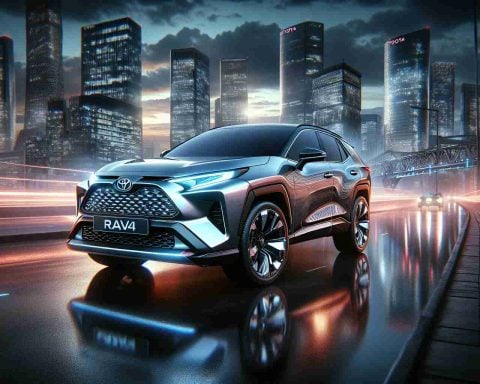China continues to set the pace in the global automotive industry, with electric and plug-in hybrid vehicle sales soaring to unprecedented levels in 2024. This surge comes despite a rampant price war, with government initiatives promoting greener vehicle trade-ins significantly boosting consumer interest.
As the world’s largest auto market, China’s impressive growth contrasts sharply with the stagnation seen elsewhere. Local manufacturers like BYD, Geely, and Xiaomi are reaping the benefits, while Tesla also noted record sales in China, defying the overall decline in its international figures. Conversely, foreign companies such as General Motors, Toyota, and Volkswagen find themselves grappling with stiff competition from domestic players, leading to decreased market share.
According to the China Passenger Car Association, total passenger vehicle sales rose by 5.3% to reach 23.1 million units last year, marking the fourth consecutive year of growth. Sales of new energy vehicles (NEVs), which include electric and plug-in hybrids, escalated by a remarkable 40.7%, accounting for nearly half of all car sales. A significant contributor to this rise has been the government’s subsidy initiative, offering up to $2,800 for NEV purchases—a figure that vastly surpasses the $2,000 incentive for traditional combustion vehicles. Over 60% of the subsidized sales were for NEVs, signaling a strong shift towards more sustainable transportation solutions in China.
China’s Electric Vehicle Boom: Unraveling the 2024 Automotive Revolution
The automotive landscape is witnessing a remarkable transformation in 2024, spearheaded by China’s unwavering dominance in electric and plug-in hybrid vehicle sales. This boom has not only defined China as the largest auto market globally but also illustrated significant trends indicating a move towards sustainability and innovation in the automotive industry.
Trends in Electric Vehicles (EVs)
China’s initiatives to support the electric vehicle market have led to a staggering 40.7% increase in new energy vehicle (NEV) sales in recent years. These policies, particularly the generous subsidies, have incentivized consumers to opt for greener options when purchasing a vehicle.
Innovations Driving Change
1. Battery Technology Advances: A key factor contributing to China’s NEV success is the rapid innovation in battery technology. Companies are focusing on developing high-capacity batteries that charge faster and last longer, enhancing the appeal of electric vehicles.
2. Smart Connectivity: Many Chinese automotive manufacturers are incorporating cutting-edge technology into their vehicles, including AI-powered features, real-time navigation, and enhanced safety protocols, making these EVs more attractive to tech-savvy consumers.
Consumer Insights
The enthusiasm for NEVs is largely fueled by changing consumer preferences. Environmental consciousness is rising among Chinese consumers, who are increasingly prioritizing sustainability in their purchasing decisions. Moreover, the combination of government support and innovative technology is reshaping how consumers perceive the value of electric vehicles.
Comparisons with Global Markets
While China experiences robust growth in EV sales, the market in other regions, notably in the U.S. and Europe, has shown signs of stagnation. This contrast is influencing global manufacturers to adapt their strategies to remain competitive. Traditional automotive giants like General Motors, Toyota, and Volkswagen are now accelerating their investments in electric vehicle technology to counter the advancements made by domestic brands in China.
Limitations and Challenges
Despite the soaring sales, the Chinese automotive market also faces challenges, including:
– Environmental Concerns: Although NEVs are marketed as eco-friendly, concerns about the environmental impact of battery production and disposal continue to surface.
– Market Saturation: With the rapid influx of new models, the market could face saturation leading to intensified competition and price wars.
– Supply Chain Issues: As seen globally, disruptions in the supply chain, particularly concerning semiconductor availability, could hinder production rates.
Pricing Strategy and Market Dynamics
The pricing strategies employed by Chinese manufacturers are a crucial factor in their success. Competitive pricing for NEVs, supplemented by extensive government subsidies that can reach up to $2,800, helps make these vehicles appealing compared to conventional combustion vehicles, which only enjoy a $2,000 subsidy.
Future Predictions
Looking ahead, analysts predict that the Chinese automotive market will continue to evolve, with significant innovations on the horizon. Expected trends include:
– Increased Market Penetration: Expansion of NEV sales both domestically and in international markets.
– Advanced Autonomous Driving: Development and deployment of autonomous vehicle technology as regulatory frameworks evolve.
– Sustainability Initiatives: A push towards sustainable manufacturing practices and enhanced recycling programs for batteries.
Conclusion
China’s remarkable growth in the electric vehicle market is redefining the automotive landscape on a global scale. As local manufacturers aggressively innovate and adapt to consumer demands, foreign companies may need to rethink their strategies or risk falling behind. The shift towards NEVs heralds not just a change in product offerings but an entire transformation of consumer behavior, market dynamics, and environmental impact. For more insights on this dynamic industry, visit automotive.com.













